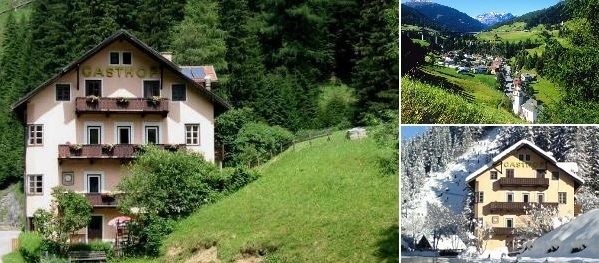District Innsbruck Land Vehicle registration IL Area 55.8 km² Local time Friday 1:58 PM Area code 05274 | Time zone CET (UTC+1) Elevation 1,165 m Population 1,265 (1 Apr 2009) Postal code 6156 | |
 | ||
Website www.griesambrenner.tirol.gv.at Weather 6°C, Wind N at 18 km/h, 39% Humidity | ||
Gries am Brenner is a municipality in the Wipptal in the southern district of Innsbruck-Land. The village consists of several hamlets.
Contents
- Map of 6156 Gries am Brenner Austria
- Geography
- Origin
- Coat of Arms
- Church of the Visitation of Mary
- Church of St Leonard
- Church of St Jacob
- Church of the Saints Christopher and Sigismund
- Tourism
- References
Map of 6156 Gries am Brenner, Austria
Geography
Gries am Brenner is located at the entrance of the Obernbergtal on the western side of the Wipptal. Here the valley widens enough to accommodate the village, the River Sill and the B182 road; the Brenner Railway runs along the eastern side and the motorway A13 on the western, are on a higher level. Also the Lake Brennersee lies on the area of the municipality.
Origin
Gries during the Roman Empire was an important passageway station to the south, but the final settlement is in the late Middle Ages; the oldest ones, date back to the pre-Roman age, are at Nößlach and Vinader. The road was traveled by traders, travelers and pilgrims, and along the route some hamlets were built. Among the various personalities who, at various times, have passed through here, remember Charlemagne, Albrecht Drauser, Goethe and Mozart. To protect the road in the territory of Gries was built a fort, but in 1241 a conflict arose between Albert III County of Tyrol and the Diocese of Brixen, which imposed the demolition. Meinhard, Duke of Carinthia built in 1287 at Leug, just south of Gries, a fortress for the use as customs duty.
Frederick IV, Duke of Austria built nearby a small church that had, between 1461 and 1811, a own vicarate. Maximilian I, Holy Roman Emperor was a regular visitor of Gries since the territory was full of game, during his hunting expeditions stayed at the "Weißes Rößle” Inn. Gries benefited, until 1560, the wealth created by the mines in the nearby Obernbergtal, having on its territory warehouses and workshops for the manufacture of silver. In 1809 during the Tyrolean Rebellion the General Lefebvre, in retaliation for the defeat suffered by the Saxons troops near Mules, destroyed the station customs at Leug which was definitively closed in 1815. After the second world war, for some years, the coal mine was exploited to the Nößlachjoch. Following the completion of the Brenner Motorway, and the consequential diversion of the traffic, the village has turned into a pretty quiet place, with a small number of tourists. The hotels, along the way, are here since centuries because of the nature of Gries as a border place.
Coat-of-Arms
Gries am Brenner Coat-of-arms consists of three black forts on yellow background. The forts are referred to those of Leug, Schlossögg and Morhäusl. The emblem was officially January 9, 1973.
Church of the "Visitation of Mary"
The presence of a church in Gries was documented in 1531 even if it was mentioned before. A church was built in 1634 nearby the "am Gries" Inn, which was enlarged in 1676; only in 1793 had its own curate. In 1823 began the construction of a new church, completed in 1828, in the typical baroque style, that in Tyrol, had been widely used by Franz de Paula Penz.
Church of “St. Leonard"
The church of “St. Leonard”, situated at Vinader, was probably built before 1000, but it is mentioned only in 1337. The church underwent an enlargement and renovation, in Gothic style, in 1489. Vinader, in 1550, was elevated to Vicariate to which were annexed the villages of the Sill Valley from Stafflach to Brennersee, including Obernbergtal. The church was transformed in 1802 in Baroque style, leaving the portal and the bell tower in the Gothic.
Church of "St. Jacob "
The church of "St. Jacob", located in the village of Nößlach, is cited for the first time in a letter dated to 1426. In 1494 the church underwent a renovation with the construction of a new altar, still in use, and underwent a major renovation in 1661.
Church of the "Saints Christopher and Sigismund"
Frederick IV Duke of Austria built at Leug, near the customs station, a small Gothic church, with a wide and squat bell tower looking like Romanesque. In 1684 the church underwent restoration with the addition of a vestibule and turning the interior to Baroque.
Tourism
Gries am Brenner is the base for both winter and summer tourism. It is possible to reach the Sattelbergalm, located at 2115 m. at the border saddle, become known and well equipped ski resort and summer destination for excursions.
